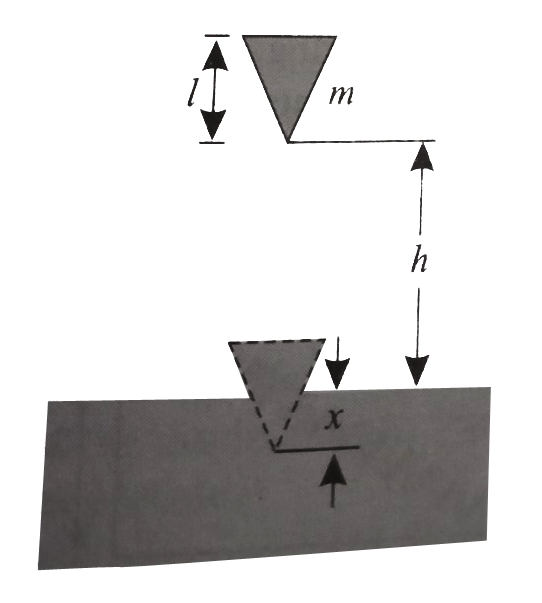A body of mass 0.02 kg falls from a height of 5 metre into a pile of sand. The body penetrates the sand a distance of 5 cm before stoping. What force has the sand exerted on the body ?
1.96N
−19.6N
−0.196N
0.0196N
The correct Answer is:2
To find the force exerted by the sand on the body, we can follow these steps:
Step 1: Calculate the velocity of the body just before it hits the sand.
We can use the equation of motion:
v2=u2+2as
where:
- v = final velocity (just before hitting the sand)
- u = initial velocity (0 m/s, since it starts from rest)
- a = acceleration due to gravity (approximately 9.8m/s2)
- s = height from which the body falls (5 m)
Substituting the values:
v2=0+2×9.8×5
v2=98
v=√98≈9.9m/s
Step 2: Calculate the change in kinetic energy as the body penetrates the sand.
The kinetic energy (KE) just before hitting the sand is given by:
KE=12mv2
where:
- m = mass of the body (0.02 kg)
- v = velocity just before hitting the sand (9.9 m/s)
Substituting the values:
KE=12×0.02×(9.9)2
KE=12×0.02×98
KE=0.01×98=0.98J
Step 3: Calculate the work done by the sand.
The work done by the sand (W) is equal to the change in kinetic energy, which is equal to the initial kinetic energy since the final kinetic energy is 0 (the body comes to rest):
W=−KE=−0.98J
Step 4: Relate work done to force exerted by the sand.
The work done by the force exerted by the sand can also be expressed as:
W=F×d
where:
- F = force exerted by the sand
- d = distance penetrated into the sand (5 cm = 0.05 m)
Rearranging gives:
F=Wd
Substituting the values:
F=−0.980.05
F=−19.6N
Conclusion:
The force exerted by the sand on the body is approximately −19.6N. The negative sign indicates that the force exerted by the sand is in the opposite direction to the motion of the body.
---
We can use the equation of motion:
v2=u2+2as
where:
- v = final velocity (just before hitting the sand)
- u = initial velocity (0 m/s, since it starts from rest)
- a = acceleration due to gravity (approximately 9.8m/s2)
- s = height from which the body falls (5 m)
v2=0+2×9.8×5
v2=98
v=√98≈9.9m/s
The kinetic energy (KE) just before hitting the sand is given by:
KE=12mv2
where:
- m = mass of the body (0.02 kg)
- v = velocity just before hitting the sand (9.9 m/s)
KE=12×0.02×(9.9)2
KE=12×0.02×98
KE=0.01×98=0.98J
The work done by the sand (W) is equal to the change in kinetic energy, which is equal to the initial kinetic energy since the final kinetic energy is 0 (the body comes to rest):
W=−KE=−0.98J
The work done by the force exerted by the sand can also be expressed as:
W=F×d
where:
- F = force exerted by the sand
- d = distance penetrated into the sand (5 cm = 0.05 m)
F=Wd
Substituting the values:
F=−0.980.05
F=−19.6N
The force exerted by the sand on the body is approximately −19.6N. The negative sign indicates that the force exerted by the sand is in the opposite direction to the motion of the body.
Topper's Solved these Questions
- BOOK - VMC MODULES ENGLISHCHAPTER - LAWS OF MOTION EXERCISE - ENABLE50videos
LAWS OF MOTION
- BOOK - VMC MODULES ENGLISHCHAPTER - LAWS OF MOTION EXERCISE - EFFICIENT50videos
LAWS OF MOTION
- BOOK - VMC MODULES ENGLISHCHAPTER - KINEMATICS OF A PARTICLE EXERCISE - JEE Advanced (archive)14videos
KINEMATICS OF A PARTICLE
- BOOK - VMC MODULES ENGLISHCHAPTER - LIQUIDSEXERCISE - JEE ADVANCED (LEVEL -2)55videos
LIQUIDS
Similar Questions
A ball is dropped from a height of 5 m onto a sandy floor and penetrates the sand up to 10 cm before coming to rest. Find the retardation of the ball in and assuming it to be uniform.
View SolutionA body of mass 0.2 kg falls from a height of 10 m to a height of 6 m above the ground. Find the loss in potential energy taking place in the body.
[g=10ms−2]View Solution
Knowledge Check
- Question 1 - Select One
If a body of mass 5 kg is lifted from the ground level to a height of 5m then ratio of its inertia is …………..
A1:1BsameCconstantDnot defined
An iron nail of mass m is dropped from a height h from level of a sand bed. If it penetrates through a distance x in the sand before coming to rest. Calculate the average force exerted by the sand on the nail. (Take g=10m/s2)
View SolutionA body of mass m=2kg falls from a height h=10m from the ground level .
What is the magnitude of total change in momentum of the body before it strikes the ground?
View Solution
A cone of mass m falls from a height h and penetrates into sand. The resistance force R of the sand is given by R=kx2. If the cone penetrates up to a distance x=d where d<λ, then find the value of k.View SolutionA body of mass 5 kg is raised vertically to a height of 10 m by a force 170 N. The velocity of the body at this height will be
View SolutionA body of mass m=1kg falls from a height h=20m from the ground level .
(a) What is the magnitude of total change in momentum of the body before it strikes the ground?
(b) What is the corresponding average force experienced by it ?(g=10ms−1)View SolutionA force acts for 10 s on a stationary body of mass 100 kg, after which the force ceases to act. The body moves through a distance of 100 m in the next 5 s. Calculate: The velocity acquired by the body
View SolutionA body of mass m falls down through a height h. Obtain an expression for the work done by the force of gravity
View Solution
